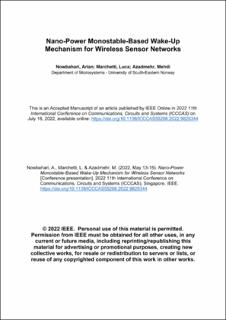| dc.contributor.author | Nowbahari, Arian | |
| dc.contributor.author | Marchetti, Luca | |
| dc.contributor.author | Azadmehr, Mehdi | |
| dc.date.accessioned | 2022-10-20T09:24:27Z | |
| dc.date.available | 2022-10-20T09:24:27Z | |
| dc.date.created | 2022-08-16T12:52:52Z | |
| dc.date.issued | 2022 | |
| dc.identifier.citation | Nowbahari, A., Marchetti, L. & Azadmehr, M. (2022, 13.-15. mai). Nano-Power Monostable-Based Wake-Up Mechanism for Wireless Sensor Networks [Paperpresentasjon]. 2022 11th International Conference on Communications, Circuits and Systems (ICCCAS), Singapore. IEEE. | en_US |
| dc.identifier.isbn | 978-1-6654-6989-0 | |
| dc.identifier.uri | https://hdl.handle.net/11250/3027249 | |
| dc.description.abstract | Wireless sensor networks (WSNs) generally consist of thousands of sensor nodes, each one supplied by a battery or harvested energy. To prolong the lifetime of wireless sensor networks, wake-up receivers (WuRxs) are typically employed. WuRxs can selectively activate sensor nodes by decoding a signal called wake-up call (WuC). Therefore, they optimize the power management of WSNs, by allowing communication when requested. In this article, an ultra-low power implementation of a sequential WuRx concept is proposed. The WuRx is composed of AND gates, switches, and monostable circuits. The monostable circuit is implemented through a transistor that generates a pulse according to a simple RC network and a switch. The proposed WuRx decodes the WuC signal by comparing the duty cycle of the received signal with the output signals of the monostable circuits. The ultra-low power implementation is validated at simulation level. The WuRx consumes 32.8nW when decoding a 3-bit wake-up call signal and 153nW when decoding 11 bits. | en_US |
| dc.language.iso | eng | en_US |
| dc.relation.ispartof | The 11th International Conference on Communications, Circuits and Systems (ICCCAS 2022) | |
| dc.title | Nano-Power Monostable-Based Wake-Up Mechanism for Wireless Sensor Networks | en_US |
| dc.type | Chapter | en_US |
| dc.description.version | acceptedVersion | en_US |
| dc.rights.holder | © 2022 IEEE. | en_US |
| dc.source.pagenumber | 187-191 | en_US |
| dc.identifier.doi | https://doi.org/10.1109/ICCCAS55266.2022.9825344 | |
| dc.identifier.cristin | 2043387 | |
| dc.relation.project | Norges forskningsråd: 273248 | en_US |
| cristin.ispublished | true | |
| cristin.fulltext | original | |
| cristin.fulltext | postprint | |
| cristin.qualitycode | 1 | |
